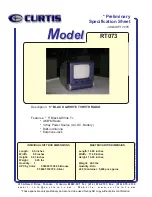
2-2 5100 ES Series Portable Radio Service Manual
Battery, Accessory and Disassembly Information
2.1.2 Battery Charging
Note
Do not charge the battery with radio power on.
The battery can be charged separately or while attached to the radio. When it is charged
while attached to the radio, radio power should be turned off. If it is not, the battery begins
slowly discharging when the trickle charge mode is entered. The trickle mode is indicated
by a green Ready indication, and it is entered automatically when the battery is nearly
fully charged. Gradual discharging occurs in the trickle mode because the charge current
of approximately 50 mA is less than the radio standby current of 200 mA.
Do not transmit in close proximity to the charger base.
Do not expose the charger base to high level RF signals while a battery is being charged
because this may cause a charger fuse to blow (especially in the UHF range). Radios
programmed for SMARTNET/SmartZone operation, for example, may affiliate while in
the charger which causes them to key automatically. Therefore, do not leave radio power
on while charging as described above.
2.1.3 Preventing Loss of Encryption Keys
If Infinite Key Retention is not programmed, the transceiver must be connected to a
constant power source to preserve the encryption keys in memory. Storage capacitors
maintain the supply voltage (and these keys) for approximately 30 seconds to allow the
battery to be changed. Therefore, when changing the battery of a transceiver containing
keys, make sure to reattach another battery within 30 seconds.
Models with Flash code 1.11.0 or later can be programmed for Infinite Key Retention. The
keys are then stored in memory and are not lost, even if power is disconnected for an
extended period.
2.1.4 Battery Care
Do not incinerate a battery pack because of the risk of explosion. Also, do not short circuit
the terminals because the battery pack and the object causing the short may become very
hot. Do not disassemble or modify a battery pack.
Proper battery care enhances the useful life of the battery. The battery should be recharged
as soon a practical after the low battery indication appears (see Section 3). Follow the
charging instructions in the manual included with the charger. When the battery fails to
hold a charge or provides only a very short operating time, it must be replaced with a new
unit.
A fully charged battery provides approximately 13 hours of service before recharging is
required. This time assumes that 5% of the time is spent transmitting, 5% in the receive
CAUTION
!
WARNING
!
Содержание 5100 ES
Страница 2: ......
Страница 4: ......
Страница 12: ...viii 5100 ES Series Portable Radio Service Manual January 2007 List of Tables continued Table Page ...
Страница 38: ...3 2 5100 ES Series Portable Radio Service Manual January 2007 Operation ...
Страница 70: ...6 2 5100 ES Series Portable Radio Service Manual January 2007 Alignment Procedure ...
Страница 74: ...7 4 5100 ES Series Portable Radio Service Manual January 2007 Troubleshooting ...
Страница 125: ...January 2007 5100 ES Series Portable Radio Service Manual 9 47 Parts List Figure 9 4 Front Housing Assembly Model III ...
Страница 126: ...January 2007 5100 ES Series Portable Radio Service Manual 9 48 Parts List Figure 9 5 Front Housing Assembly Model II ...
Страница 127: ...January 2007 5100 ES Series Portable Radio Service Manual 9 49 Parts List Figure 9 6 Front Housing Assembly Model I ...
Страница 132: ...January 2007 5100 ES Series Portable Radio Service Manual 9 54 Parts List Figure 9 11 Front Cover Assembly Model II III ...
Страница 133: ...January 2007 5100 ES Series Portable Radio Service Manual 9 55 Parts List Figure 9 12 Front Cover Assembly Model I ...
Страница 134: ...January 2007 5100 ES Series Portable Radio Service Manual 9 56 Parts List Figure 9 13 Front Cover Assembly Detail ...
Страница 180: ...10 46 5100 ES Series Portable Radio Service Manual January 2007 Schematic Diagrams and Component Layouts ...
















































